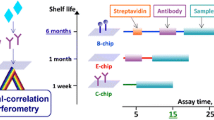Abstract
A fiber-optic immunosensor for quantifying the protein C (PC) amount in a plasma sample is being developed to provide accurate, fast, cost-effective diagnosis of heterozygous PC deficiency (0.5–2.5 μgml−1). As a progress report on the sensor development, this paper focuses on optimizations of various assay steps. These include: (1) the primary antibody concentration; (2) the effect of the primary antibody leaching on the sensitivity; (3) the fluorophore to secondary antibody ratio; and (4) the sample and secondary antibody incubation times. The optimal primary antibody concentration for the PC sensor was determined to be 65 μgml−1; its leaching was minor, stabilized within 3 days, and the sensor sensitivity change after 30 days of storage was minor; sample and secondary antibody incubation times were reduced from 10 to 5 and from 5 to 3 min, respectively, while maintaining a reasonable signal-to-noise level. The immunosensor was also tested with (5) human serum albumin and human plasma and (6) with and without convective flow. High viscosity of human plasma decreased signal intensity, but clear signal discrimination was possible in the concentration range of interest. (7) Application of convective flow increased the signal intensity by increasing PC mass transport rate to the sensor surface. The optimized PC immunosensor provides a smaller (100 μl sample chamber) and faster (10–15 min) tool for PC detection in human plasma. © 2002 Biomedical Engineering Society.
PAC02: 8780-y, 8714Ee
Similar content being viewed by others
REFERENCES
Balcer, H. I., J. O. Spiker, and K. A. Kang. Sensitivity of protein C immunosensor with and without human serum albumin. Adv. Exp. Med. Biol. 471:605-612, 1999.
Bertina, R. M. Assays for protein C. In: Protein C and Related Proteins, edited by R. M. Bertina. Edinburgh: Churchill Livingstone, 1988, pp. 130-150.
Bhatia, S. K., L. C. Shriver-Lake, K. J. Prior, J. H. Georger, J. M. Calvert, R. Bredehorst, and F. Ligler. Use of thiolterminal silanes and heterobifunctional crosslinkers for immobilization of antibodies on silica surfaces. Anal. Chem. 178:408-413, 1989.
Bird, R. B., W. E. Stewart, and E. N. Lightfoot. Theories of ordinary diffusion in liquid. In: Transport Phenomena. New York: Wiley, 1960, p. 514.
Griffin, J. H., B. Evatt, T. S. Zimmerman, A. J. Kleis, and C. Wideman. Deficiency of protein C in congenital thrombotic disease. J. Clin. Invest. 68:1370-1373, 1981.
Kisiel, W. Human plasma protein C. Isolation, characterization, and mechanism of activation by a-thrombin. J. Clin. Invest. 64:761-769, 1979.
Spiker, J. O., K. A. Kang, W. N. Drohan, and D. F. Bruley. Protein C detection via fluorophore mediated immuno-optical biosensor. Adv. Exp. Med. Biol. 428:621-627, 1997.
Spiker, J. O., K. A. Kang, W. N. Drohan, and D. F. Bruley. Preliminary study of biosensor optimization for the detection of protein C. Adv. Exp. Med. Biol. 454:681-688, 1998.
Spiker, J. O., and K. A. Kang. Preliminary study of real-time fiber optic based protein C biosensor. Biotechnol. Bioeng. 66:158-163, 1999.
Author information
Authors and Affiliations
Rights and permissions
About this article
Cite this article
Balcer, H.I., Kwon, H.J. & Kang, K.A. Assay Procedure Optimization of a Rapid, Reusable Protein C Immunosensor for Physiological Samples. Annals of Biomedical Engineering 30, 141–147 (2002). https://doi.org/10.1114/1.1433487
Issue Date:
DOI: https://doi.org/10.1114/1.1433487




